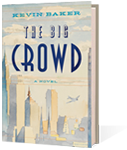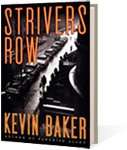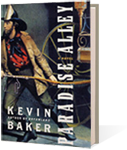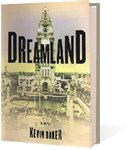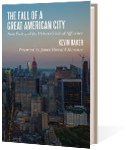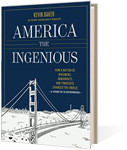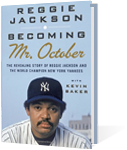WHY AMERICA LOVED ROOSEVELT FIFTY YEARS AFTER HIS DEATH, RECALLING THE POWER OF HIS PRINCIPLED PRAGMATISM
His mother’s first ancestor came to America pursuing Priscilla Alden, and his grandfather made his fortune selling opium in China. His father’s family was one of the oldest in New York, and had once owned what became 130 blocks of East Harlem. His father lived his own, eminently contented life twice over: When his wife died, and his son married, and his house on the Hudson River burned down, he bought a new manor house, fell in love with another spirited young woman and had another son The son was Franklin Delano Roosevelt, and this Wednesday is the 50th anniversary of his death on April 12, 1945. It was a death-like his life, and the lives of his family-inextricably entwined into the fabric of American history.
The very date connotes how young our country still was—and is—and how far it had advanced upon the world stage. Roosevelt died 85 years, almost to the day, after Abraham Lincoln-also at the finish of a great war, with all the attendant echoes of sacrifice and rebirth.
It was, appropriately, a grand exit. Roosevelt died of a cerebral hemorrhage in Warm Springs, Ga., and it was nearly two days before the train carrying his coffin and his widow could make its way up to Washington. The coffin sat in the last car, guarded by one man from each of the service branches, and as it passed, thousands of Southerners, black and white alike, knelt and prayed by the tracks, or sang “Rock of Ages” and “Abide With Me” and “Onward, Christian Soldiers”-the hymn he and Winston Churchill had sung so defiantly together, four years before.
They were joined by the nation in their grief. “I’m walking south on Michigan Boulevard and I can’t stop crying. Everybody is crying,” wrote Studs Terkel. Outright strangers told John Gunther, “I never met him, but I feel as if I had lost my best friend.”
In the capital there was a solemn procession through the streets, the coffin draped with an American flag, carried on a caisson pulled by six white horses. The funeral was held in the East Room of the White House, and when the service began America was silent. “That Saturday afternoon was probably the quietest of the war,” wrote William Manchester, in his brilliant account of FDR’s death and burial.
The radio went still for the moment-and carried no commercials for four days. Newspapers carried no ads that day. Buses, streetcars, automobiles stopped where they were. Movie theaters and grocery stores closed their doors.
The next day the funeral train resumed its journey home, to the president’s estate at Hyde Park, and thousands more lined the tracks-families, Boy Scout troops, a troop of monks from a Hudson River monastery; weeping and waving, or standing in stiff, stunned silence. The West Point corps of cadets met the train and marched with the president’s hearse up the winding road from the Hudson River siding to the family rose garden. There waited much of the Congress, the Supreme Court, the new president and his family, Eleanor Roosevelt and her daughter Anna and son Elliott. (Sons John, James and Franklin Jr. were still at war.) There were also 883 veterans from every service; Geoffrey Ward, in his superb study of FDR, noted that “The medals and decorations they wore recorded the trials of the great war that Roosevelt had directed and whose end he had not lived to see—North Africa and Monte Cassino, Guadalcanal andMidway, Tarawa and Normandy.” Here, Franklin Roosevelt was laid to rest, with a solemn Episcopal benediction and a 21-gun salute. A riderless horse with its stirrups reversed stood outside the garden; a single bomber flew overhead, emblem of the brave, barbaric new world the president had guided the nation through.
The whole pageant would become a landmark for a generation, no less than Nov. 22, 1963, would be for those to follow: “Where were you when Roosevelt died?” It is nearly impossible today to imagine a leader, or a setting, that would evoke such an outpouring of grief and reverence from around the country and the rest of the world. It was something beyond mere popularity. FDR’s death marked the passing of a presidency we can barely understand today. “In his lifetime, he was literally worshiped by many Americans,” wrote biographer William Leuchtenburg. “One congressman compared him to Jesus Christ and in a poll of New York schoolchildren, God ran a poor second.”
Fifty years later, the second Roosevelt remains an American icon (at least, among that shrinking percentage who can still tell you who was president when World War II was fought). For all the controversy now swirling around the welfare state he put into place, many of its most virulent detractors still hold FDR in awe. No less than Ronald Reagan and Newt Gingrich have called him the greatest president of our century. Yet there remains something elusive about the Roosevelt legacy-as there was something elusive about the man during his life. “He had not a personality, but a ring of personalities, each one dissolving on approach, always revealing still another beneath,” wrote Arthur Schlesinger Jr.
Somehow, even in our reverence, we have not embraced his memory with the same affection we reserve for such homespun, more straightforward presidents as Lincoln, or Harry Truman. There was, perhaps, always something a little too regal, too mythic about the life of Franklin Roosevelt for the likes of a democracy.
The trappings were more those of an English lord than an American politician. This was a man, after all, whose father was called “Mr. James” by the local Hyde Park villagers; they used to touch their hands to their caps when he rode by. His life often seemed driven by a destiny too heavy-handed for the most shameless paperback saga.
As a young lawyer, he calmly informed his colleagues that he would be president one day. He planned to copy the rise of his famous cousin Teddy step-by-step: Start out in the state legislature, become assistant secretary of the Navy, then governor, and chief executive. The grandiose daydreams of a young man—except that he did it all, just as he said he would, and married Teddy’s favorite niece in the bargain. Years before he contracted the polio that crippled him, sculptor Paul Troubetskoy depicted the agile youthful FDR only from the thighs up, claiming, “I can’t see Franklin with legs.”
It was a fantastic life, lived at a pivotal moment in world history. Yet if anything, Roosevelt’s reputation these days is in danger of becoming underrated.
He was not, it is widely agreed, a deep thinker. Oliver Wendell Holmes’ famous assessment that FDR possessed “a second-rate intellect but a first-rate temperament” is widely quoted-though in fact Roosevelt was at least as intelligent and well-educated as all but a handful of the 41 men who have occupied the White House. He has been censured for being unfaithful to his remarkable wife. It has been argued that he did not use his power often or effectively enough to help African Americans, or to oppose the internment of the Nisei, or to rescue European Jews from the Holocaust.
Others have criticized him for moving too slowly in prodding the United States into World War II-or for moving without the proper authority of Congress. He has been blamed for not making the reforms of the New Deal deep or consistent—and for dangerously expanding the power of the presidency.
All these critiques have at least some validity. Yet somehow, when it was all over, everything-to use Yeats’ words-was “Changed/ Changed utterly.”
What did he accomplish? It is vital that we understand it now, as we consider making fundamental alterations in his legacy. Essentially, he preserved and enlarged the promise of human freedom in our time. Or, as Joseph Alsop put it, “On a very wide front and in the truest possible sense, Franklin Delano Roosevelt included the excluded.”
It is difficult for us now to conceive of just how different America and the world were when Roosevelt came to power-or how different they might have been had he not come to power. It was, in Schlesinger’s phrase, “a frightened age when the air was filled with the sound of certitudes cracking on every side.” No other American leader-not even Lincoln-has ever faced such complex and potentially lethal crises as the Great Depression and the Second World War.
The America of 1933, racked by four years of depression, was all but exhausted with democracy. Every bank in the country was in the process of closing its doors. Thousands of square miles of farm land had become a desert. Between one-quarter and one-third of the work force was unemployed, and millions of Americans were being evicted from their homes, their land every year.
What we forget is that the Great Depression was neither a natural catastrophe nor an isolated event. Things had never been quite so bad, but every five to 10 years, for the better part of a century, the country had suffered a wrenching economic collapse-much worse than any recession we have endured since World War II. Bank failures and Wall Street panics were common, and usually led to nationwide meltdowns.
Most elderly Americans lived in abject poverty. Working men and women worked six days a week, 12 to 16 hours a day. They were routinely joined at the job by their children; few people ever finished high school, let alone college.
A system of apartheid, rationalized by bad science and enforced by lynching, ruled in the South. Another system of quotas routinely kept blacks, women, Jews and ethnic whites out of the best jobs and schools. Farmers could rarely make a living; more and more were reduced to the serfdom of share-cropping. Nine-tenths of rural Americans did not even have electricity.
The root causes of these conditions were basic, longstanding flaws in American democracy. More shocking than the conditions in which Americans of 1933 lived was how little say they had in anything that mattered. Banking and investment were dominated by a small circle of self-interested, often dishonest men. Politics in every large city was usually controlled by corrupt political machines. In the South, millions of blacks and poor whites were kept from the ballot box by poll taxes, literacy tests and force of arms.
The power of landlords and large corporations was rarely contained. Unions were small and powerless. The courts repeatedly struck down the most basic minimum wage, child labor, consumer protection and worker safety laws.
The Great Depression only brought these ongoing social crises to a head—yet few at the time saw more democracy as an answer. The very idea of democracy seemed to be outmoded in the swift and steely industrial world. Hard new nostrums abounded in the 1930s and ’40s: communism, fascism, socialism, technocracy, corporatism.
Liberal democracy—and Roosevelt—succeeded in their rough, inconsistent way because that is the way of the world. What Roosevelt possessed was the essential flexibility of mind for a democracy. It was indicative that during his first presidential campaign he promised above all “bold, persistent experimentation. It is common sense to take a method and try it. If it fails, admit it frankly and try another. But above all, try something.”
Not everything he tried worked well, and some things did not work at all, and many of the New Deal’s innovations have required revision. Roosevelt himself would have been baffled by the notion that they would not, for he was not erecting a Marxist utopia but a viable, modern democracy. What he did was to turn his entire administration into an ongoing debate on democracy. For all the recent attention to the Clintons’ weekends with like-minded policy wonks, Roosevelt had everyone from NormanThomas to John Maynard Keynes up to the Oval Office. “If one definition of genius is an infinite capacity to make use of everyone and everything …,” wrote Manchester, “then Roosevelt certainly qualified.”
Best of all, he extended this debate into the living rooms of every home in America. FDR gave the press unprecedented access to the White House, and there were the “fireside chats.” “As he talked, his head would nod and his hands would move in simple, natural, comfortable gestures,” Secretary of Labor Frances Perkins recalled of these radio addresses. “His face would smile and light up as though he were actually sitting on the front porch or in the parlor with them.”
The gestures—and many of the words—may have been homey enough, but the fireside chats were in fact amazingly detailed lessons in how our country works. Before reopening the nation’s failed banks during his first weeks in office, for example, FDR took to the airwaves to explain how modern banking operated, and how it had been reformed: “… I know that when you understand what we in Washington have been about I shall continue to have your cooperation … ,” he intoned withhis usual grand confidence, and he was right.
Yet for all his democratic pragmatism, we look for something more. The life of Richard Nixon provides us with an example of what can come from expediency ungrounded in any deeper principle.
Was there any guiding spirit, anything more to Franklin Delano Roosevelt than tactics and timing, to account for the great outpouring of grief 50 years ago?
There are at least two stories from his life that I think are telling. One was the account that he was unimpressed by the Grand Canyon: “It looks dead. I like my green trees at Hyde Park better. They are alive and growing.” “He responded to what was vital, not to what was lifeless; to what was coming, to what was passing away,” wrote Schlesinger. “He lived by his exaltation in distant horizons and uncharted seas.”
The other story is from when he was first trying to win back some use of his legs after the attack of polio that crippled him. He would try, every day, to make it the quarter of a mile from his Hyde Park home to the post office on his crutches.
It was a torturous journey for a man with no working muscles from his hips down. Sometimes he would fall—and have to wait, lying face down in the road, for someone to come along and help him back up. “{F}or better or worse, I believe that the Roosevelt who could not walk was in most respects very like the one who could,” writes Geoffrey Ward, and most current biographers would concur. It was Roosevelt’s already strong, optimistic-and deceptive -character that got him through the lossof his legs to polio, and not the polio that built the character.
Yet what better training has any president had—in patience, in humility, in building a basic sympathy for the human condition? Franklin Roosevelt understood the clumsy, halting progress of us all, and nurtured it, and the American people loved him for it as they have loved few men since.
© Copyright The Washington Post Company


